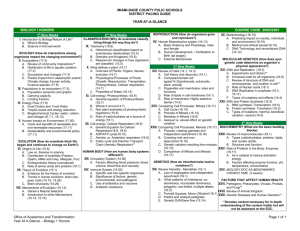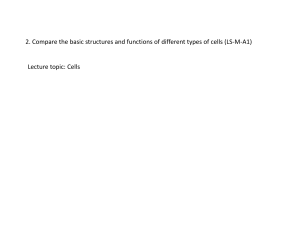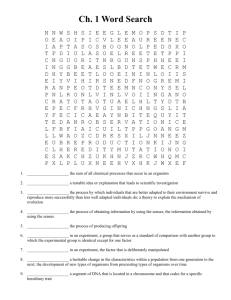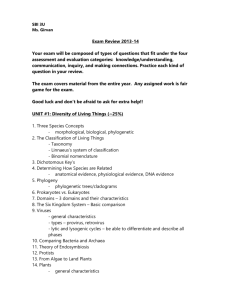7 Grade Life Science – Focal Points th
advertisement
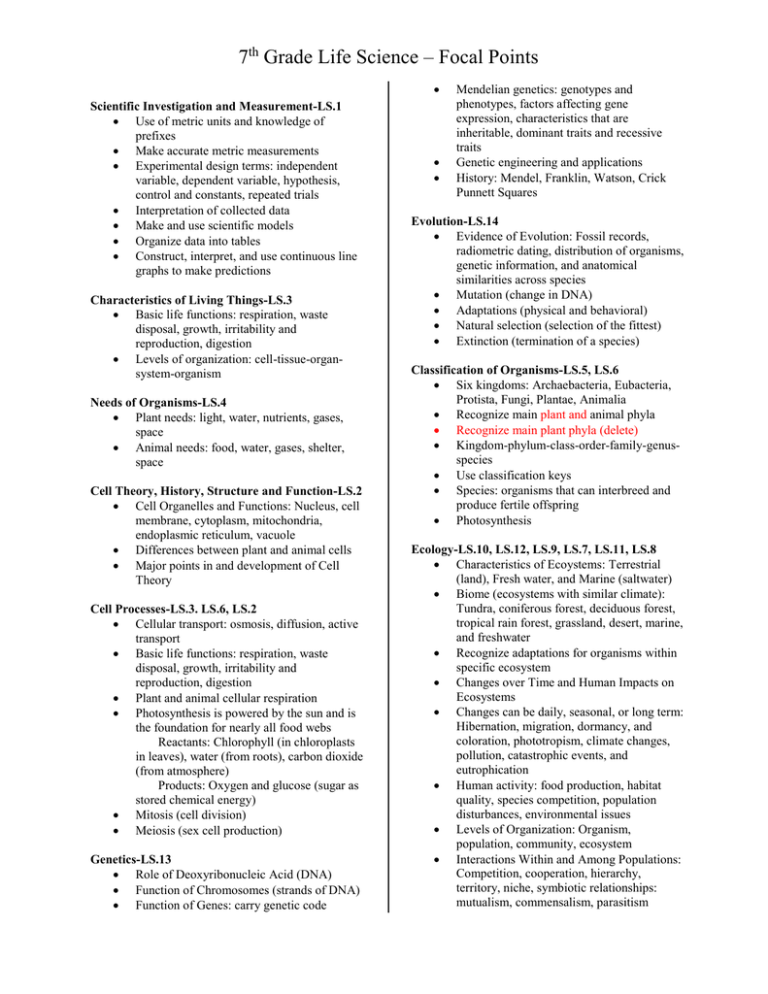
7th Grade Life Science – Focal Points Scientific Investigation and Measurement-LS.1 Use of metric units and knowledge of prefixes Make accurate metric measurements Experimental design terms: independent variable, dependent variable, hypothesis, control and constants, repeated trials Interpretation of collected data Make and use scientific models Organize data into tables Construct, interpret, and use continuous line graphs to make predictions Characteristics of Living Things-LS.3 Basic life functions: respiration, waste disposal, growth, irritability and reproduction, digestion Levels of organization: cell-tissue-organsystem-organism Needs of Organisms-LS.4 Plant needs: light, water, nutrients, gases, space Animal needs: food, water, gases, shelter, space Cell Theory, History, Structure and Function-LS.2 Cell Organelles and Functions: Nucleus, cell membrane, cytoplasm, mitochondria, endoplasmic reticulum, vacuole Differences between plant and animal cells Major points in and development of Cell Theory Cell Processes-LS.3. LS.6, LS.2 Cellular transport: osmosis, diffusion, active transport Basic life functions: respiration, waste disposal, growth, irritability and reproduction, digestion Plant and animal cellular respiration Photosynthesis is powered by the sun and is the foundation for nearly all food webs Reactants: Chlorophyll (in chloroplasts in leaves), water (from roots), carbon dioxide (from atmosphere) Products: Oxygen and glucose (sugar as stored chemical energy) Mitosis (cell division) Meiosis (sex cell production) Genetics-LS.13 Role of Deoxyribonucleic Acid (DNA) Function of Chromosomes (strands of DNA) Function of Genes: carry genetic code Mendelian genetics: genotypes and phenotypes, factors affecting gene expression, characteristics that are inheritable, dominant traits and recessive traits Genetic engineering and applications History: Mendel, Franklin, Watson, Crick Punnett Squares Evolution-LS.14 Evidence of Evolution: Fossil records, radiometric dating, distribution of organisms, genetic information, and anatomical similarities across species Mutation (change in DNA) Adaptations (physical and behavioral) Natural selection (selection of the fittest) Extinction (termination of a species) Classification of Organisms-LS.5, LS.6 Six kingdoms: Archaebacteria, Eubacteria, Protista, Fungi, Plantae, Animalia Recognize main plant and animal phyla Recognize main plant phyla (delete) Kingdom-phylum-class-order-family-genusspecies Use classification keys Species: organisms that can interbreed and produce fertile offspring Photosynthesis Ecology-LS.10, LS.12, LS.9, LS.7, LS.11, LS.8 Characteristics of Ecoystems: Terrestrial (land), Fresh water, and Marine (saltwater) Biome (ecosystems with similar climate): Tundra, coniferous forest, deciduous forest, tropical rain forest, grassland, desert, marine, and freshwater Recognize adaptations for organisms within specific ecosystem Changes over Time and Human Impacts on Ecosystems Changes can be daily, seasonal, or long term: Hibernation, migration, dormancy, and coloration, phototropism, climate changes, pollution, catastrophic events, and eutrophication Human activity: food production, habitat quality, species competition, population disturbances, environmental issues Levels of Organization: Organism, population, community, ecosystem Interactions Within and Among Populations: Competition, cooperation, hierarchy, territory, niche, symbiotic relationships: mutualism, commensalism, parasitism 7th Grade Life Science – Focal Points Energy Flow and Cycles: Cycles in nature: Water, nitrogen and carbon Food webs (combination of food chains) – energy flow Producers, Consumers, Herbivore, carnivore, omnivore, decomposer Energy pyramid (reduction of energy as you go up the pyramid) Predator/prey relationships
